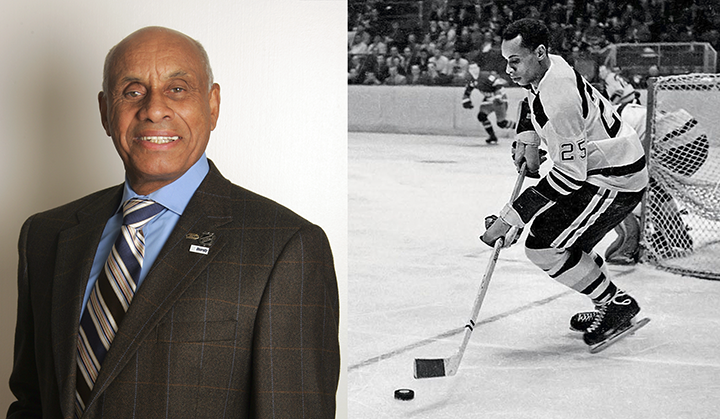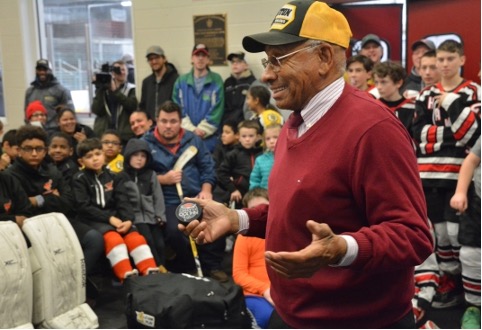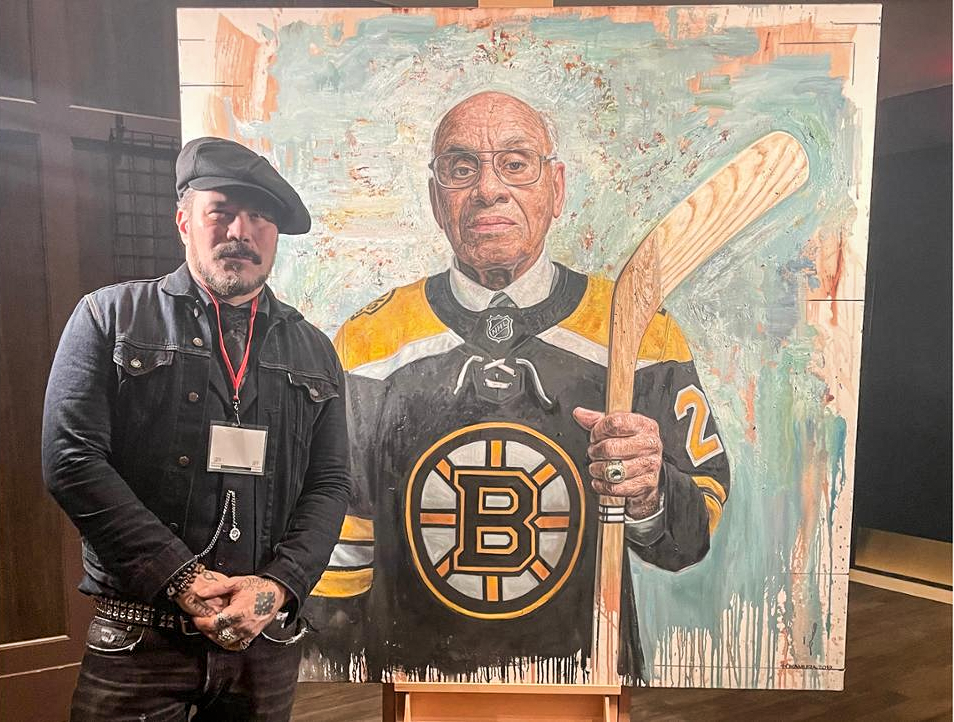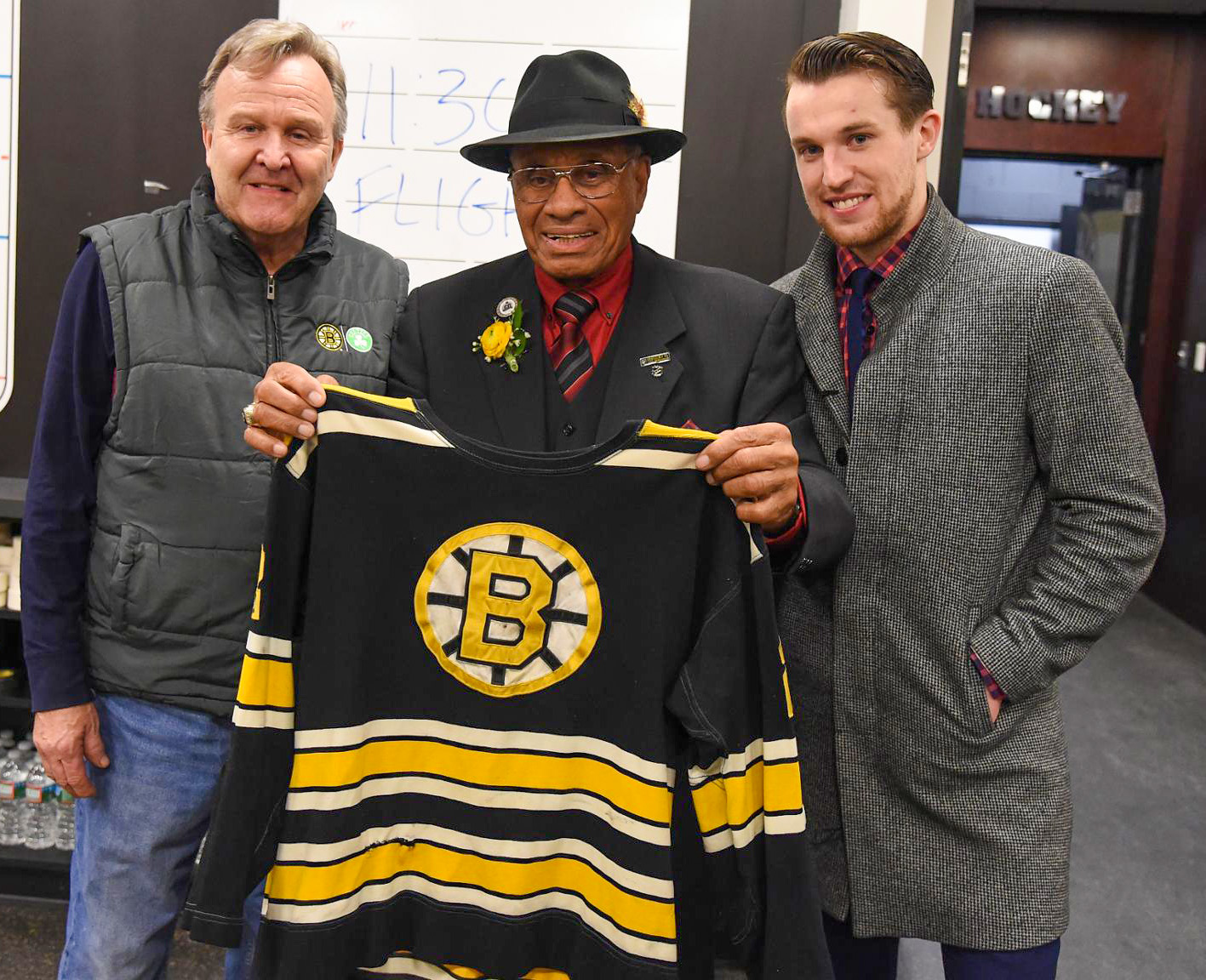An Evening with Willie O’Ree

Trail-blazing athlete, youth ambassador, and positive role model
Report by Rod Brazier
On February 15, 2023, and in keeping with Black History Month, we were joined via ZOOM by Mr. Willie O’Ree, member of the Hockey Hall of Fame, recipient of the Order of Canada, and first person of colour to play in the National Hockey League (NHL). Willie joined us from his home in California by phone, as unfortunately his internet connection had been lost due to bad weather.
Mr. O’Ree’s time with us was ably facilitated by Bill Tupper, who introduced Willie and also served as a master of ceremonies, prompting Willie to share with us various aspects of his long and illustrious career in hockey, both as a player, as well as a highly valued ambassador for the NHL.
By way of introduction, Bill provided a broad overview of Willie’s career milestones and accomplishments. The notes that follow include Bill’s overview points, with elaboration from Willie.
Formative Years, and a Career Choice Point
Willie O’Ree was born in Fredericton in 1935, the youngest of 13 children. He first picked up a hockey stick at age three, and began his organized hockey career at the age of five. Beginning with the 1950-51 season he progressed through the Fredericton Capitals Junior and Senior ranks, scoring 15 goals in 25 playoff games with the senior club in 1953-54.
Moving to junior hockey league ranks at age 19 in 1954-55, Willie played one year with the Quebec Aces of the QHL, where he scored 43 points in 43 games. The following year, while playing for the Kitchener Canucks of the OHL, Willie suffered a potentially career-ending injury.
Willie relates that there were no helmets or face protection at the time, and he was hit by a slapshot from the point which ricocheted off a stick and hit him in the right eye, also breaking his nose and cracking his cheek bone.
Following emergency surgery, the surgeon told Willie he was blind in his right eye, and that he’d “never play hockey again.”
Although initially and understandably distraught at the prospect of having his two main life goals – playing professional hockey, and making it to the NHL – taken from him, Willie realized that, except for being blind in one eye, all his other abilities remained! Consequently, he was back skating in about five weeks, and playing competitively shortly after that.
Willie told us the main limitation of his blindness was that, as a left winger blind in his right eye, he had to turn his head all the way over his right shoulder to see what was happening in the rest of the ice surface! Ultimately, rather than bemoaning what he was missing due to his injury, he determined that he would focus on what he CAN see rather than what he CAN’T.
Willie had not told his family (with the exception of his sister, whom he swore to secrecy) about his blindness, so when he returned to Fredericton at the end of the season, everyone thought he was fine, and were thankful for his “full” recovery!
Getting On with a Career – and Making History
During the following post-season, which saw Willie spending a lot of time working out at the gym, he received a call from Punch Imlach, then the manager of the Quebec Aces, inviting him to the Aces training camp. He made the team (having still not disclosed his blindness!)
The following year (1957-58) he went to the Boston Bruins training camp (the Aces were affiliated with the Bruins). He didn’t make the team, and so returned to the Aces. However, on January 18th of that year the Bruins called him up.
Before the game Willie met with Bruin coach Milt Schmidt and General Manager Lynn Patrick; both men expressed confidence that he could add something to the team. The Bruins beat the Montreal Canadians at the old Montreal Forum that night, and while he was returned to Quebec following the two-game home-and-home series with Montreal, Willie O’Ree, the 22 year old from Fredericton New Brunswick, had made history by breaking the NHL colour barrier!
Willie played with the Boston Bruins in 1960-61, scoring his first NHL goal on January 1, 1961, but at the beginning of the 1961-62 season he was traded to Montreal, and played briefly with their farm team in Hull, Quebec, before being traded to the Los Angeles Blades of the WHL. He played six years with the Blades before moving to the San Diego Gulls in 1967, where he remained for seven years before retiring in 1974. However, in 1978 he was asked to try out with the San Diego Hawks. He made the team, but the 1978-79 season became Willie O’Ree’s last as a professional hockey player; he had been a pro for 21 years.
The Secret Finally Revealed
While Willie ended his description of his playing days on that note, Bill deftly added that during his time in the Western Hockey League he won two scoring titles, and had four years in which he scored 30 or more goals. That prompted Willie to tell us about attending the Los Angeles Blades training camp in 1965. At the time the team had seven or eight left wingers, but only one right wing player. Consequently, the coach asked him to play right wing, a move which allowed Willie to see much more of the ice surface without turning his head as he had to on left wing. That switch resulted in Willie’s first league scoring title, an achievement he repeated with San Diego in 1968-69!
Post-Playing Days
Asked if he would share with us his experiences since retiring, Willie was happy to oblige; it was clear he had great passion for and pride in the work he has done – and continues to do since retiring as a player.
Willie told of how he wanted to continue his association with hockey after retiring, not just because he felt he had something to give back to the game, but also give back to the community. As he was considering his options (scouting, coaching, community service, etc.) he worked several jobs unrelated to hockey. He worked in construction, sold cars for a time, and was with a security firm for fifteen years, all the while never losing sight of his goal of returning to hockey in some capacity.
A Dream Realized
In 1996 he received a call from Brian McBride, the NHL’s new Vice-President of Diversity programs. Brian had been trying for some time to locate Willie, without success. However, having finally got the FBI involved, Willie was tracked down in a matter of hours!
The NHL wanted to know if Willie would be interested in working in their diversity programs with kids. Once Willie was assured he could work out of his home in San Diego rather than move to New York, he was “in.”
His job was to travel to local schools, boys & girls clubs, juvenile detention facilities, YM/YWCA etc. in North America promoting participation in hockey, and talking about the importance of setting personal goals , believing in yourself, and working hard to achieve what you want. His personal mantra was, “if you think you can – you can; if you think you can’t – you’re right.”
In 1998, NHL President Gary Bettman appointed Willie NHL Director of Youth Development and Diversity Ambassador, a post he still holds.
Return of a Lost Treasure
Bill asked about Willie’s connection to a Boston player Matt Grzelcyk and his father John, who at one time was a member of the Boston Garden crew that would convert the Garden from one type of event to another (eg. hockey to basketball.) As it turns out, at the end of the 1960-61 season, when Willie was playing with the Bruins, Grzelcyk Sr. came into possession of Willie’s hockey jersey, possibly via a Bruin’s trainer who felt the jersey was too worn to be of further service.
Willie was traded to Montreal in that off-season, so never returned to the Garden. The jersey hung in the Grzelcyk home for 60 years, the Grzelcyks uncertain of its significance until more recent years.
On January 18, 2018, the day the Mayor of Boston had proclaimed Willie O’Ree day, John and Matt Grzelcyk returned the jersey to its original wearer, and act of generosity for which Willie had trouble finding words.
Recognition
In recent years Willie has been the recipient of a number of accolades, awards and tokens of recognition for his contributions to hockey, and to the causes of participation, inclusion and diversity. One such act of recognition occurred in 2021when, partially in celebration of Black History month all NHL players had helmet decals honouring Willie.
Of particular note is the awarding to Willie in 2022 of the U.S. Congressional Gold Medal, the highest honour bestowed upon a civilian. The award must be voted – with a 2/3 majority – by the House of Representatives. The vote was unanimous, and the associated Bill has received Presidential approval. Once the US Mint has settled on a design of the medal it will be struck, and Willie will be invited to Washington for a formal presentation ceremony. Willie will be the first hockey player, and the first winter sport athlete to receive this medal.
Asked by Bill if there was anything else he would like to share with us, Willie focused on his involvement with the NHL and its “Hockey is for Everyone” program. He so enjoys the time he spends with youngsters, and related it to a favourite quote: “Find a job you love and you’ll never work a day in your life.” He hopes to be able to continue doing it for some time to come. Willie also gave great credit to his associate Rob Wooley, who is instrumental in handling Willie’s itinerary, setting up events and assisting in multiple ways.

A question was asked about the salaries Willie had received in his playing days. His response was that when he first turned professional with the Quebec Aces in 1958 his basic salary was $3,500, with a $500 signing bonus. While the salary wasn’t considered too bad for six months work, a player still had to get another job in the off-season. The most money he made playing professional hockey was with the San Diego Hawks -- $17,000 (1979-80)
Giulio Maffini offered that he thought Willie is a true inspiration to all of us, in terms of his attitude toward life and the desire to seek change where it is needed. We are grateful for his willingness to share his life experiences with us. In response, Willie noted that he has had a good life in his 87 years and, if given the chance, he would probably live it the same way.
In his final “thank you” to Willie, Bill acknowledged and thanked Rob Wooley, who was also on the call, and is an indispensable part of Willie’s team, and he thanked Willie for the pleasure his stories and insights have brought us, and the evening of treasure he has bestowed. Willie responded by lamenting that we couldn’t see each other due to the internet problem, but perhaps we’ll get another opportunity down the road, when he expects to have more memories to share.

Willie O’Ree Awards & Tributes
1984 – New Brunswick Sports Hall of Fame
1985 – Fredericton proclaims Jan. 18 as Willie O’Ree Day
2003 – Lester Patrick Award (U.S.)
2005 – Order of New Brunswick
2008 – Dedication of Willie O’Ree Place – Fredericton
2008 – Jan 18 designated Willie O’Ree Day (Fredericton)
2008 – Order of Canada
2018 – Hockey Hall of Fame (builder category)
2021 – Canada Sports Hall of Fame (builder category)
2022 – Bruins retire #22 (Jan 18)
2022 – US Congressional Gold Medal
2023 – Portrait of Willie O’Ree unveiled in the Lord Beaverbrook Art Gallery in Fredericton
By Rod Brazier

